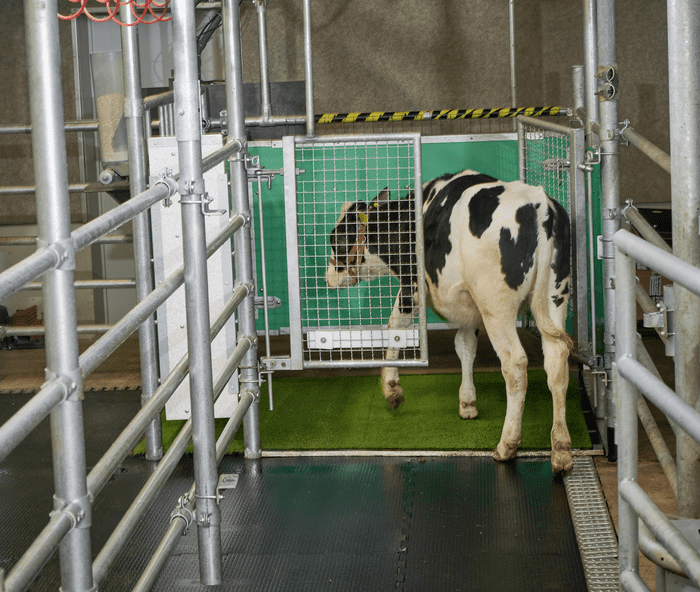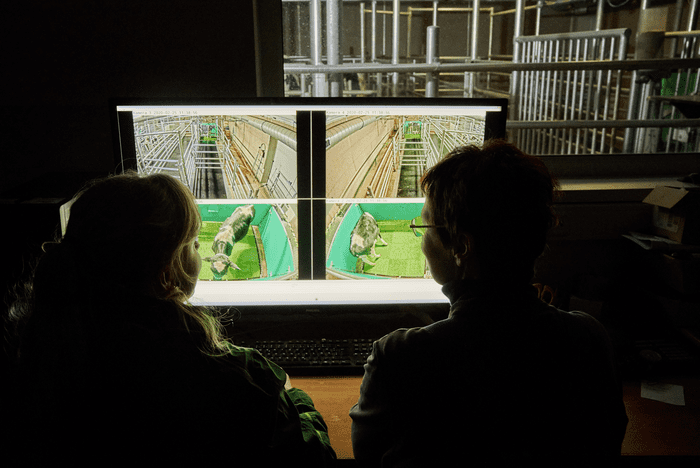
Cow farms produce a lot of waste that harms the environment by producing greenhouse gases and contaminating the local soil and waterways. Researchers in Germany want to minimize these impacts by proposing a seemingly wacky, but effective and novel way to manage cattle urine and feces: just potty-train the cows.
Just crazy enough to work
The beef and dairy industry is among the most environmentally damaging in the world for a myriad of reasons. Intensive livestock breeding requires a lot of feedstock, water, and land, and produces copious amounts of greenhouse gases that heat the planet’s atmosphere.
A report by the UN’s Food and Agriculture Organization estimates that livestock accounts for nearly 15% of man-made greenhouse gas emissions. You may have heard that a lot of methane is produced by cattle burps and farts, but they produce another potent greenhouse gas that is often overlooked.
When a cow’s feces and urine combine, they produce ammonia due to the enzymatic hydrolysis of urea in the urine by urease in the feces. Further down the stream, when ammonia is leached into the soil, microbes eat it up, generating nitrous oxide as a byproduct, the third-most important greenhouse gas after methane and carbon dioxide.
“About 95% of ammonia emissions come from agriculture, and a considerable proportion comes from cattle farming, either directly from barn air or indirectly from slurry. Ammonia is an indirect greenhouse gas. Ammonia is responsible for a large amount of atmospheric N deposition which in turn leads to eutrophication of the soil and water, soil acidification, and direct plant damage. In accordance with the National Emission Reduction Commitment (NERC) from 2016, Germany has committed itself to reduce its emissions of ammonia by 29% compared to 2005. Ammonia is released when urine and feces meet. It is formed by the enzymatic hydrolysis of urea in the urine by urease in the feces,” Jan Langbein, an animal psychologist at the Research Institute for Farm Animal Biology (FBN) and co-author of the new study, told ZME Science.
If you thought cows are dumb, I have moos for you. Cows are actually quite intelligent animals that are known to interact in socially complex ways. For instance, they can develop friendships over time and, conversely, will sometimes hold grudges against other cows that treat them badly.
Far from being mere burger and milk machines, cows are sentient and well emotionally developed. Cognitively speaking, they have a level of performance comparable to that of children, with research showing they possess complex spatial memory, can discriminate between individual cows or humans, and display a full range of personality traits, such as shyness, boldness, sociability, and gregariousness.
Bearing all of this in mind, the researchers in Germany believed that cows were clever enough to be potty-trained — and they were right.
Writing in the journal Current Biology, they describe their process, dubbed MooLoo training, by which 16 calves were trained to urinate in latrines fitted inside their barn with a combination of reward and mild punishment.

After they became accustomed to the experimental environment and learned how to enter and exit the gates to the latrine, the cows were taught how to use them. Every time they urinated into the designated area, they received a food reward consisting of a mixture of molasses and glucose or crushed barley. When they urinated outside the toilet, the researchers conditioned them against this behavior by inflicting a mild punishment. Initially, the negative stimulus consisted of playing an annoying sound through headphones placed inside the cow’s ears, however, the animals couldn’t seem to care less. Ultimately, a spray of water worked as a gentle deterrent, and the researchers stuck with that for the rest of the training.
In time, 11 out of the 16 calves learned to enter the latrine only when they needed to urinate and how to use the toilets properly, thereby avoiding ammonia production.
The researchers are confident they can refine their training method to improve their training conversion and scale it even for farms with thousands of individuals.
“We are preparing a follow-up project, in which we want to realize our results, which were worked out under experimental conditions, under practical conditions. For this purpose, the entire training procedure must be automated. Appropriate sensors should detect urination and trigger a reward output in case of urination in the latrine. For now, we are focusing on dairy cows that are kept indoors. In the pasture, the distances for the cow are significantly longer,” Langbein said.
Building designated latrines, fitting them with sensors and automation machines, and training calves sounds prohibitively expensive — and it might very well be. However, seeing how the livestock sector generates copious amounts of emissions, farmers may be incentivized to go down this route through government subsidies. Alternatively, a carbon tax may level the playing field in the market by rewarding farmers who produce less ammonia with carbon credits.
In the not-so-distant future, don’t be surprised to see cows queuing for the toilet like in a busy pub.


